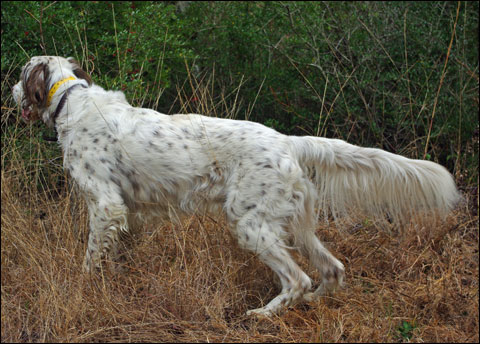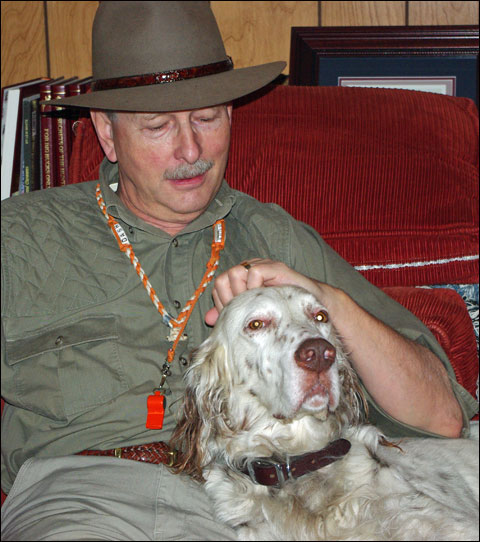Hunting With Dez Young

I had watched the dog and his man many a Saturday on the Outdoor Life Network. “Hunting with Hank” was unique – a bird hunting show about a Llewellin setter and his sidekick, Dez Young. Because of its reversal of star status, “Hunting with Hank” stood out among other hunting programs. And that was as Dez intended it from the beginning.
The opportunity to meet Dez, and his new star Dash, son of Hank, came this January at Ted Everett’s Hard Labor Creek hunting preserve in Chipley, Florida. Sitting on the sofa at the lodge, with Dash spread across him like a favorite blanket, Dez explained how it all began.
 Dash delivers a quail to Dez Young Young at Hard Labor Creek.
Dash delivers a quail to Dez Young Young at Hard Labor Creek.
“When my wife, Karenanne, decided she wanted to start upland bird hunting, and almost simultaneously we lost our last Labrador, I decided it was time to switch to a pointing breed of some sort.”
That was in 1993, and Dez researched every pointing breed, balancing all their pros and cons, before deciding on the American Llewellin setter. From there, he researched breeders and selected Alfred King of Arkansas.
“We really became fast friends over the phone. I told him to please let me know when he had another litter, and we could discuss getting a male pup. Once they were born, we stayed in touch and he kept me up on each puppy. After six weeks, I knew exactly which puppy I wanted. A week later, Hank arrived at Delta Cargo in Portland, and our adventures began.”
Dez decided to train Hank on his own – the first time he had trained a pointing dog and he admits he was absolutely terrified. But by the time fall rolled around, Dez was taking Hank out in the field, and Hank was taking compliments from all who hunted over him.
“Friends were sending me bottles of wine, and tickets to ball games, all because they enjoyed Hank so much. They absolutely loved him.”
Dez owned his own marketing firm at that time, but had a history of entertaining including singing and playing guitar on stage and television. Through Hank, he began to see a connection between his past and his future.
 Dash on point while hunting quail at Hard Labor Creek.
Dash on point while hunting quail at Hard Labor Creek.
“The second year of Hank’s hunting, I went to Karenanne, and told her that I’d like to develop a bird hunting show starring Hank, and not me. She said, ‘that’s a great idea.’”
So using their own money, they created a pilot show the following winter, and by spring the Outdoor Life Network agreed to air the “Hunting with Hank” series.
“We did six years, 67 episodes. The last episodes of Hank were right here at Hard Labor Creek.”
From Hank’s last litter of puppies came Dash. Just like Hank, Dez started training Dash at seven weeks. And because Hank was still alive when Dash’s shows began being taped, he was the guest star on the first three episodes.
“I had the opportunity to hunt with Hank and his son in front of me for those first shows. What a thrill that was for me to have both boys together. One of the highlights of that first show was when Hank went on his first point, Dash backed his dad. He’d never been taught that.”
Dez believed that 10 years was too long to keep hunting a dog on camera, as he’d done with Hank. So in 2007, he retired Dash after five years and 62 episodes of “Dash in the Uplands” and “Upland Days with Dez and Dash.”
 Dez Young (left), Dash and Hard Labor Creek owner, Ted Everett.
Dez Young (left), Dash and Hard Labor Creek owner, Ted Everett.
“The main reason we’re here now at Hard Labor Creek is because Hank was 10 on his last visit. And now Dash is 10. I’ve known the owner Ted Everett since we brought Hank here. A terrific guy and he was a big fan of Hank’s, so it was a lot of fun for Ted to get to meet Hank and watch him work.”
Hunting with Dez and Dash at Hard Labor Creek was a blast for all involved. I was impressed with Dash’s energy, despite his age. But with so much ground to cover, and temperatures in the upper 60’s, Dez kept a close eye on his boy and provided a few squirts of water every few minutes.
The quail habitat here has been carefully managed for many years, and the “labor of love” is evident. The slash pines towering over a mix of native grasses and shrubs, along with planted millet, sunflower, Egyptian wheat and corn, provide the ideal backdrop for a traditional southern quail hunt. And while most of the coveys were pen-raised, they were fast-flying and unpredictable.
To make things even more challenging, a video camera was rolling through much of the hunt. Gary Finch, host of Gary Finch Outdoors, was along, with his cameraman, Steve Layton, never far behind. “Don’t shoot the camera guy, and don’t miss a bird on-camera,” added a little pressure to the event.
I carried my Beretta 20-gauge over-and-under, which I’m fairly proficient with when hunting birds. In fact, I’m certain my sporting clays scores would be much better if the clay targets just had a few feathers. After taking down three birds behind Dash’s points, Dez informed me that he’d been offered $1,000 by a hunter wishing to hunt over Dash. He said he’d send me the bill. All in jest, I assume.
When asked about his philosophy on training dogs, Dez made the point that he is not a professional trainer. But as Hank and Dash prove, he’s a darned good amateur.
 Dez and Dash.
Dez and Dash.
“I felt the same way as I did when I was a kid; that a hunting dog ought to be part of the family. I grew up in eastern Oregon, and all the members of our family hunted. And they all had bird dogs. They were all part of the family. Everybody loved them. And I felt that was the way we should do it as well. In fact, that’s the origin of the catchphrase we put in all of our shows – ‘Never, ever spoil your bird dog.’ There are still professional trainers who feel like a bird dog should be strictly that. They believe that you take away some of their hunting desire if you allow them to become a member of your family. And so when we started Hank’s series, I came up with this concept of poking a little fun at that by spoiling Hank on every show in some way. Lounging on a sofa together or sharing a sandwich were not uncommon.”
More then anything else, says Dez, that suggestion to overindulge your dog became the most memorable part of the series.
“I told a lot of people that Hank was certainly not the best bird dog in the world, but he was the best bird dog in my world. I said the same thing about Dash. And lo and behold, they were both inducted into the National Bird Dog Hall of Fame.”
Dez holds several seminars each year based on his training philosophy and says one key he tries to get across is, it takes patience to train a dog. You have to be willing to help the dog understand the connection between your words and signals, and what each means.
“A new puppy doesn’t automatically know what ‘heel’ means. You have to show him. Just give him time. He’ll catch on. It’s not rocket science.”
Dez says Richard Wolters’ classic book “Gun Dog” was instrumental in training the two setters. Wolters’ idea of starting training at seven weeks caused quite a controversy when the book first came out in the early 1960s. At that time most trainers wouldn’t touch a dog until it reached six months of age.
“I used it for Hank and Dash both. Started them at seven weeks of age. By the time Dash was nine months old, we were taping his first show. It was nothing I did. Just that Dash was brilliant, like Hank. And he was patient with me. It also helped that Hank assisted in the training. Just like any good dad would do.”
Dez’s TV series were not simply a salute to two special upland bird dogs, but more an homage to every dog, be it Llewellin or Heinz 57. It was a simple message that it’s okay to treat your dog, even a pedigreed hunter, like your best friend.
Larry Chesney is a freelance writer, contributing to such magazines as Sporting Classics, North American Hunter, and South Carolina Sportsman. He resides in Taylors, South Carolina.
Please send your comments to letters@shotgunlife.com.
Useful resources:
Hard Labor Creek Plantation web site
HwH Productions web site, producers of Dez Young’s TV shows


Comments